2015 KIA Soul power steering
[x] Cancel search: power steeringPage 332 of 492
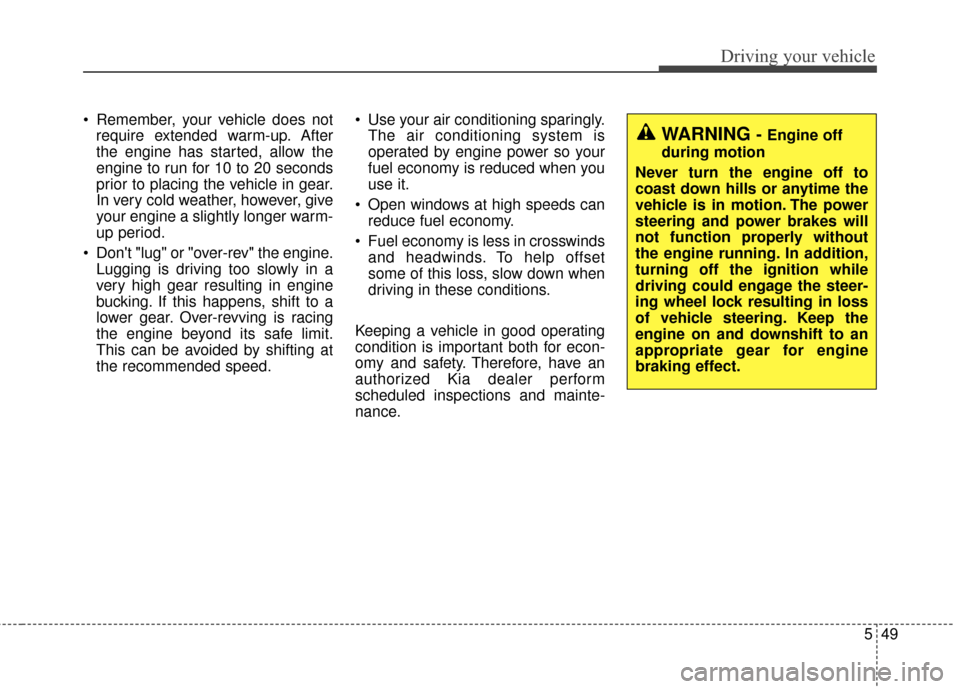
549
Driving your vehicle
Remember, your vehicle does notrequire extended warm-up. After
the engine has started, allow the
engine to run for 10 to 20 seconds
prior to placing the vehicle in gear.
In very cold weather, however, give
your engine a slightly longer warm-
up period.
Don't "lug" or "over-rev" the engine. Lugging is driving too slowly in a
very high gear resulting in engine
bucking. If this happens, shift to a
lower gear. Over-revving is racing
the engine beyond its safe limit.
This can be avoided by shifting at
the recommended speed. Use your air conditioning sparingly.
The air conditioning system is
operated by engine power so your
fuel economy is reduced when you
use it.
Open windows at high speeds can reduce fuel economy.
Fuel economy is less in crosswinds and headwinds. To help offset
some of this loss, slow down when
driving in these conditions.
Keeping a vehicle in good operating
condition is important both for econ-
omy and safety. Therefore, have an
authorized Kia dealer perform
scheduled inspections and mainte-
nance.
WARNING - Engine off
during motion
Never turn the engine off to
coast down hills or anytime the
vehicle is in motion. The power
steering and power brakes will
not function properly without
the engine running. In addition,
turning off the ignition while
driving could engage the steer-
ing wheel lock resulting in loss
of vehicle steering. Keep the
engine on and downshift to an
appropriate gear for engine
braking effect.
Page 368 of 492
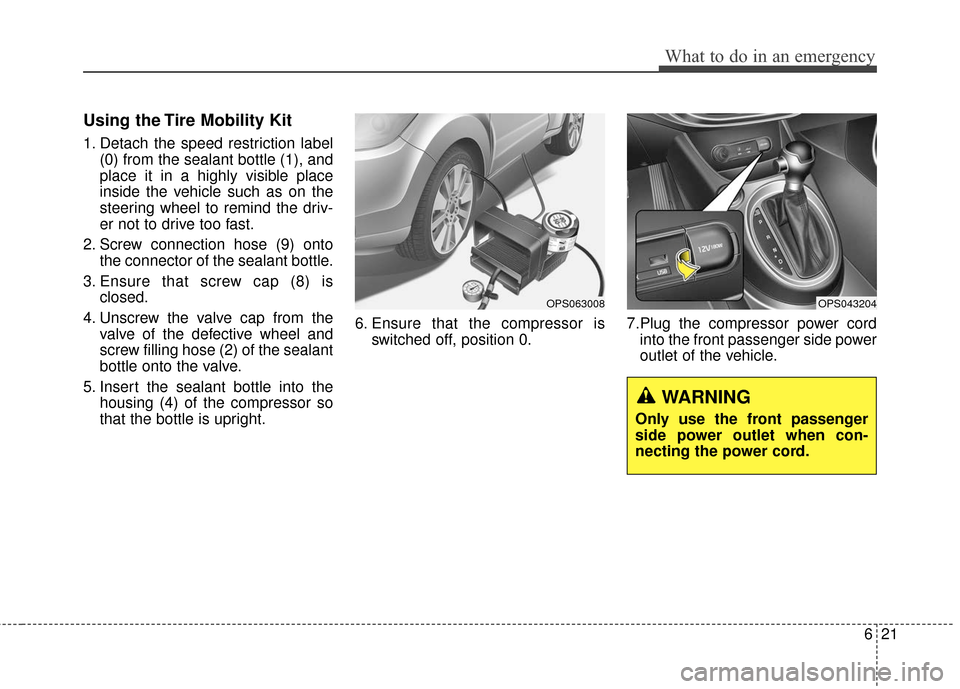
621
What to do in an emergency
Using the Tire Mobility Kit
1. Detach the speed restriction label(0) from the sealant bottle (1), and
place it in a highly visible place
inside the vehicle such as on the
steering wheel to remind the driv-
er not to drive too fast.
2. Screw connection hose (9) onto the connector of the sealant bottle.
3. Ensure that screw cap (8) is closed.
4. Unscrew the valve cap from the valve of the defective wheel and
screw filling hose (2) of the sealant
bottle onto the valve.
5. Insert the sealant bottle into the housing (4) of the compressor so
that the bottle is upright. 6. Ensure that the compressor is
switched off, position 0. 7.Plug the compressor power cord
into the front passenger side power
outlet of the vehicle.
OPS063008OPS043204
WARNING
Only use the front passenger
side power outlet when con-
necting the power cord.
Page 374 of 492
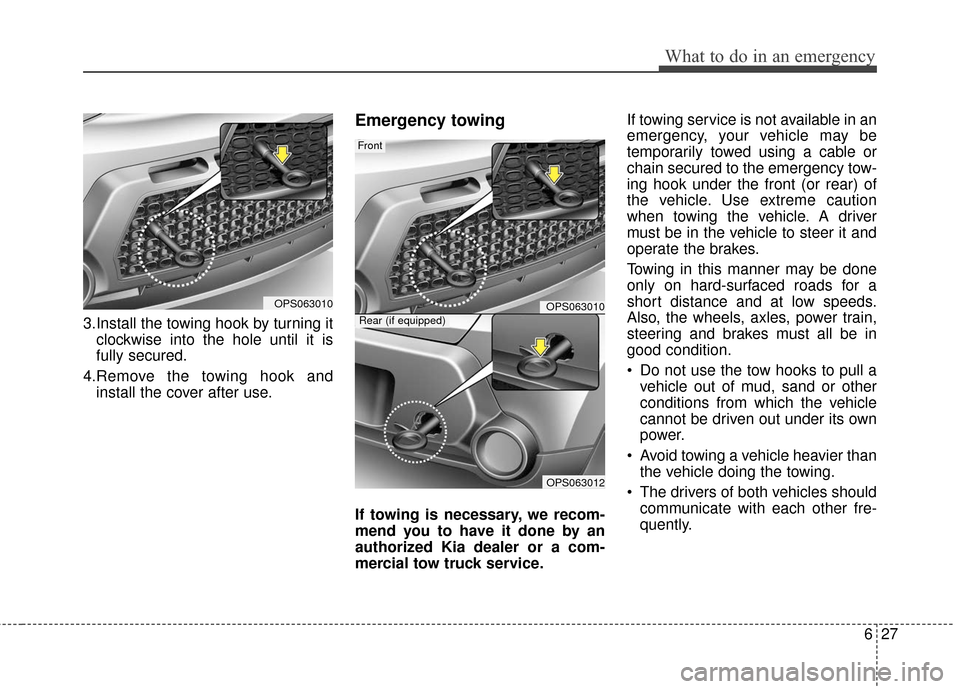
627
What to do in an emergency
3.Install the towing hook by turning itclockwise into the hole until it is
fully secured.
4.Remove the towing hook and install the cover after use.
Emergency towing
If towing is necessary, we recom-
mend you to have it done by an
authorized Kia dealer or a com-
mercial tow truck service. If towing service is not available in an
emergency, your vehicle may be
temporarily towed using a cable or
chain secured to the emergency tow-
ing hook under the front (or rear) of
the vehicle. Use extreme caution
when towing the vehicle. A driver
must be in the vehicle to steer it and
operate the brakes.
Towing in this manner may be done
only on hard-surfaced roads for a
short distance and at low speeds.
Also, the wheels, axles, power train,
steering and brakes must all be in
good condition.
Do not use the tow hooks to pull a
vehicle out of mud, sand or other
conditions from which the vehicle
cannot be driven out under its own
power.
Avoid towing a vehicle heavier than the vehicle doing the towing.
The drivers of both vehicles should communicate with each other fre-
quently.
OPS063010OPS063010
OPS063012
Front
Rear (if equipped)
Page 375 of 492
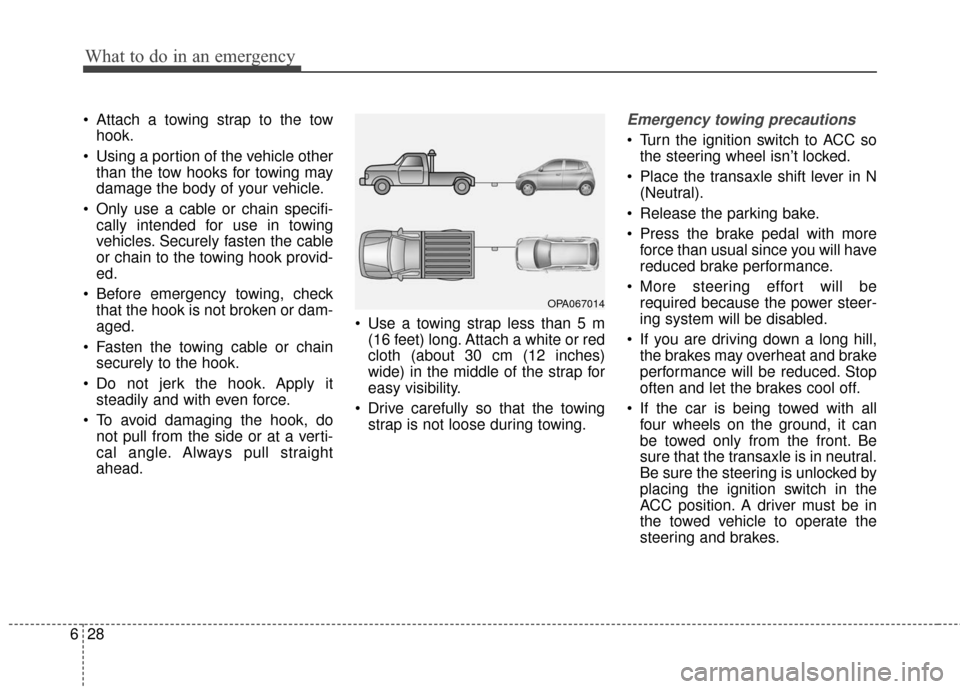
What to do in an emergency
28
6
Attach a towing strap to the tow
hook.
Using a portion of the vehicle other than the tow hooks for towing may
damage the body of your vehicle.
Only use a cable or chain specifi- cally intended for use in towing
vehicles. Securely fasten the cable
or chain to the towing hook provid-
ed.
Before emergency towing, check that the hook is not broken or dam-
aged.
Fasten the towing cable or chain securely to the hook.
Do not jerk the hook. Apply it steadily and with even force.
To avoid damaging the hook, do not pull from the side or at a verti-
cal angle. Always pull straight
ahead. Use a towing strap less than 5 m
(16 feet) long. Attach a white or red
cloth (about 30 cm (12 inches)
wide) in the middle of the strap for
easy visibility.
Drive carefully so that the towing strap is not loose during towing.Emergency towing precautions
Turn the ignition switch to ACC sothe steering wheel isn’t locked.
Place the transaxle shift lever in N (Neutral).
Release the parking bake.
Press the brake pedal with more force than usual since you will have
reduced brake performance.
More steering effort will be required because the power steer-
ing system will be disabled.
If you are driving down a long hill, the brakes may overheat and brake
performance will be reduced. Stop
often and let the brakes cool off.
If the car is being towed with all four wheels on the ground, it can
be towed only from the front. Be
sure that the transaxle is in neutral.
Be sure the steering is unlocked by
placing the ignition switch in the
ACC position. A driver must be in
the towed vehicle to operate the
steering and brakes.
OPA067014
Page 444 of 492
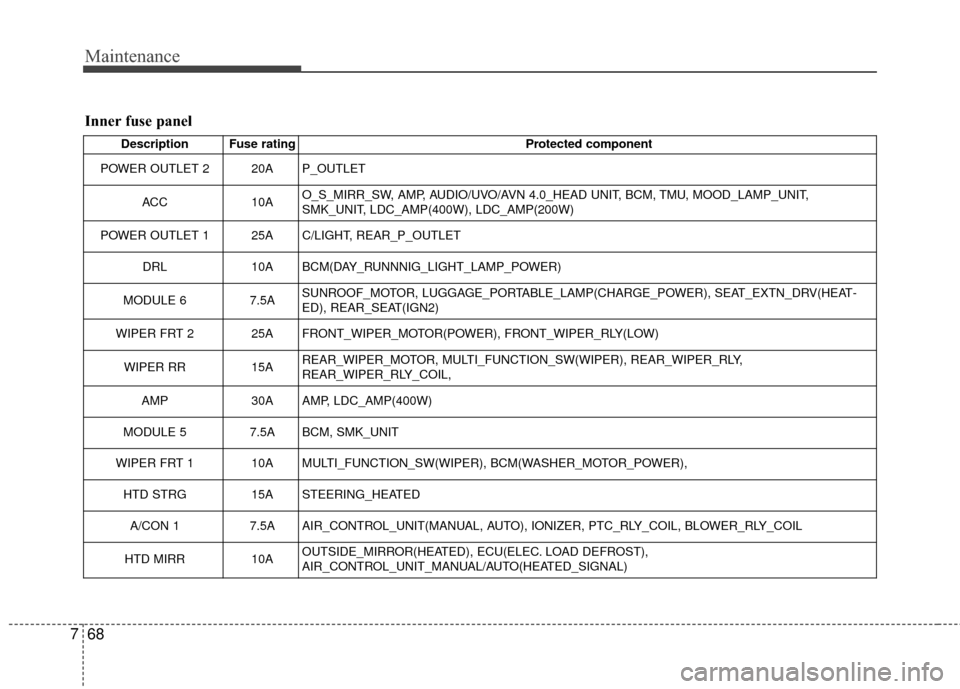
Maintenance
68
7
Inner fuse panel
Description Fuse rating Protected component
POWER OUTLET 2 20A P_OUTLET
ACC 10AO_S_MIRR_SW, AMP, AUDIO/UVO/AVN 4.0_HEAD UNIT, BCM, TMU, MOOD_LAMP_UNIT,
SMK_UNIT, LDC_AMP(400W), LDC_AMP(200W)
POWER OUTLET 1 25A C/LIGHT, REAR_P_OUTLET
DRL 10A BCM(DAY_RUNNNIG_LIGHT_LAMP_POWER)
MODULE 6 7.5ASUNROOF_MOTOR, LUGGAGE_PORTABLE_LAMP(CHARGE_POWER), SEAT_EXTN_DRV(HEAT-
ED), REAR_SEAT(IGN2)
WIPER FRT 2 25A FRONT_WIPER_MOTOR(POWER), FRONT_WIPER_RLY(LOW)
WIPER RR 15AREAR_WIPER_MOTOR, MULTI_FUNCTION_SW(WIPER), REAR_WIPER_RLY,
REAR_WIPER_RLY_COIL,
AMP 30A AMP, LDC_AMP(400W)
MODULE 5 7.5A BCM, SMK_UNIT
WIPER FRT 1 10A MULTI_FUNCTION_SW(WIPER), BCM(WASHER_MOTOR_POWER), HTD STRG 15A STEERING_HEATED
A/CON 1 7.5A AIR_CONTROL_UNIT(MANUAL, AUTO), IONIZER, PTC_RLY_COIL, BLOWER_RLY_COIL
HTD MIRR 10AOUTSIDE_MIRROR(HEATED), ECU(ELEC. LOAD DEFROST),
AIR_CONTROL_UNIT_MANUAL/AUTO(HEATED_SIGNAL)
Page 490 of 492

I7
Index
Rear camera display . . . . . . . . . . . . . . . . . . . . . . . . . . . 4-88
Recommended lubricants and capacities . . . . . . . . . . . . 8-6Recommended sae viscosity number . . . . . . . . . . . . . 8-8
Road warning . . . . . . . . . . . . . . . . . . . . . . . . . . . . . . . . . 6-2 Hazard warning flasher . . . . . . . . . . . . . . . . . . . . . . . 6-2
Scheduled maintenance service . . . . . . . . . . . . . . . . . . . 7-9
Seat belts . . . . . . . . . . . . . . . . . . . . . . . . . . . . . . . . . . . . \
3-16 Care of seat belts . . . . . . . . . . . . . . . . . . . . . . . . . . . 3-28
Pre-tensioner seat belt . . . . . . . . . . . . . . . . . . . . . . . 3-24
Seat belt precautions . . . . . . . . . . . . . . . . . . . . . . . . 3-26
Seat belt restraint system . . . . . . . . . . . . . . . . . . . . . 3-16
Seats . . . . . . . . . . . . . . . . . . . . . . . . . . . . . . . . . . . . \
. . . . 3-2 Front seat adjustment - Manual . . . . . . . . . . . . . . . . . 3-5
Front seat adjustment - Power . . . . . . . . . . . . . . . . . . 3-6
Rear seat adjustment . . . . . . . . . . . . . . . . . . . . . . . . 3-11
Seatback pocket . . . . . . . . . . . . . . . . . . . . . . . . . . . . 3-11
Smart key . . . . . . . . . . . . . . . . . . . . . . . . . . . . . . . . . . . 4-\
11 Battery replacement . . . . . . . . . . . . . . . . . . . . . . . . . 4-17
Loss of the smart key . . . . . . . . . . . . . . . . . . . . . . . . 4-14
Record your key number . . . . . . . . . . . . . . . . . . . . . 4-11
Smart key function . . . . . . . . . . . . . . . . . . . . . . . . . . 4-11
Smart key immobilizer system. . . . . . . . . . . . . . . . . 4-15
Smart key precautions . . . . . . . . . . . . . . . . . . . . . . . 4-15 Special driving conditions . . . . . . . . . . . . . . . . . . . . . . 5-50
Driving at night . . . . . . . . . . . . . . . . . . . . . . . . . . . . 5-52
Driving in flooded areas. . . . . . . . . . . . . . . . . . . . . . 5-53
Driving in the rain . . . . . . . . . . . . . . . . . . . . . . . . . . 5-53
Driving off-road . . . . . . . . . . . . . . . . . . . . . . . . . . . 5-54
Hazardous driving conditions . . . . . . . . . . . . . . . . 5-50
Highway driving . . . . . . . . . . . . . . . . . . . . . . . . . . . . 5-54
Reducing the risk of a rollover. . . . . . . . . . . . . . . . . 5-50
Rocking the vehicle . . . . . . . . . . . . . . . . . . . . . . . . . 5-51
Smooth cornering . . . . . . . . . . . . . . . . . . . . . . . . . . . 5-52
Steering wheel . . . . . . . . . . . . . . . . . . . . . . . . . . . . . . . 4-43 Electric power steering (EPS) . . . . . . . . . . . . . . . . . 4-43
FLEX steer . . . . . . . . . . . . . . . . . . . . . . . . . . . . . . . . 4-46
Heated steering wheel . . . . . . . . . . . . . . . . . . . . . . . 4-45
Horn . . . . . . . . . . . . . . . . . . . . . . . . . . . . . . . . . . . . \
. 4-45
Tilt and telescopic steering . . . . . . . . . . . . . . . . . . . 4-44
Storage compartment . . . . . . . . . . . . . . . . . . . . . . . . . 4-132 Center console storage . . . . . . . . . . . . . . . . . . . . . . 4-132
Cool box . . . . . . . . . . . . . . . . . . . . . . . . . . . . . . . . . 4-133
Glove box . . . . . . . . . . . . . . . . . . . . . . . . . . . . . . . . 4-132
Luggage box . . . . . . . . . . . . . . . . . . . . . . . . . . . . . . 4-134
Sunglass holder . . . . . . . . . . . . . . . . . . . . . . . . . . . 4-133
S
R